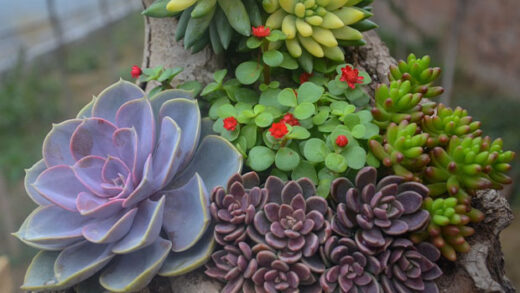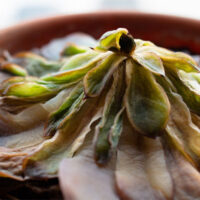Low-maintenance succulent plants are ideal for gardeners with brown thumbs. The most crucial thing to look out for when choosing the best soil for succulents in pots is how well it both absorbs and drains water. Choosing the right soil for your succulent plants is just as crucial as how frequently you water them.
The best succulents to grow in pots depend on a variety of factors, mostly the environment, which affects how quickly the soil dries out.
We’ll look at the best succulent soil so you can give your prized succulents the best environment to grow.
Table of Contents
Best Soil For Succulents In Pot: Top Picks
- 1. Espoma Cactus Soil Mix, Natural & Organic For Succulents 8 Qt
- 2. Westland Cacti & Succulent Potting Compost Mix, With Seramis, 4 L
- 3. Next Gardener Professional Grower Soil Fast Draining Pre-Mixed (2 Qts)
- 4. Wonder Soil’s Cactus & Succulent Soil Mix, 3 Lbs
- 5. Succulent Potting Mix Miracle-Gro For Cactus, Aloe Vera, and More 4 Qt.
- 6. Cactus Focus Potting Soil For Succulents 8 Litre
- 7. Hoffman Organic Cactus And Succulent Soil Mix, 4 Qrts
- 8. Perfect Plants All Natural Succulent and Cactus Soil
- 9. Superfly Bonsai Succulent & Cactus Soil Mix
The Best Soil For Succulents
1. Espoma Cactus Soil Mix, Natural & Organic For Succulents 8 Qt
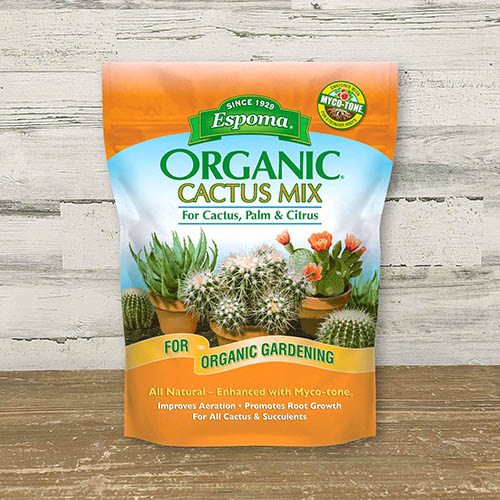
Espoma Cactus Soil Mix is a fantastic option of soil for cacti and succulents. In fact, this product works well with any plant that needs adequate aeration and drainage. Succulent growers prefer this particular soil because it encourages excellent root growth and is entirely natural and organic.
Sphagnum moss, forest products, humus, perlite, limestone—which also helps maintain the pH balance—and Yucca extracts are all included in the mixture. Consequently, a nice blend of minerals and organics. For extra drainage, I always add a little bit more perlite, grit, or gravel to my blend. I’ll admit that I have a preference for some of the soils on this list, but that’s just because I have it on hand in my garden shed. If you don’t, I wouldn’t worry too much; just be cautious about how often you water. By inserting your finger 1 cm into the soil, you can determine the moisture level. If the soil is dry, add water.
Simply plant your succulents in appropriate-sized pots with drainage holes using this potting mix, and then observe how well they do all year long. The following year, switch to a larger pot with new potting soil.
Pros
- A nice blend of Organic and Mineral products
- Epsoma has outstanding organic soil and nutrient heritage
- Suitable for use to pot other plants too
Cons
- Nothing of significance
2. Westland Cacti & Succulent Potting Compost Mix, With Seramis, 4 L
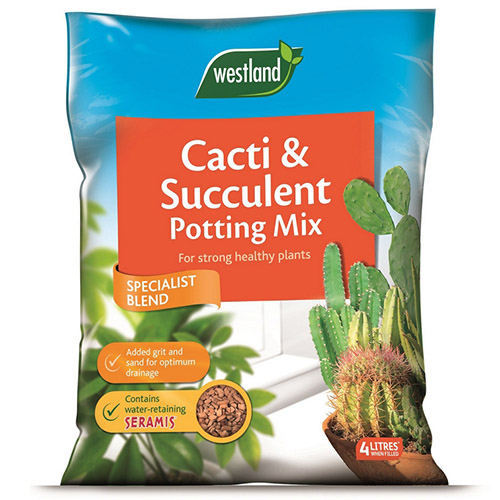
Each of the components in this Westland cacti and succulent potting mix has something to contribute to the growth of strong roots and succulent plants that are well-fed and healthy. The benefit of this potting mix is that it can be used for a variety of plants, including citrus trees, orchids, and indoor houseplants like cacti and succulents.
Westland’s clay Seramis granules and additional sand and grit help with water control by helping to drain excess water while still maintaining good moisture retention. Given the cost and the quality of the ingredients, adding some perlite or grit to this excellent value mix is not a problem. It still ranks among the best mixes of succulent soil that are readily available, and it works wonders when combined with more perlite.
Pros
- One of the top-selling products of succulent soils in the UK
- Contains clay Seramis granules
Cons
- Requires coarse minerals for the best drainage. We recommend additional perlite or grit
3. Next Gardener Professional Grower Soil Fast Draining Pre-mixed (2 Qts)
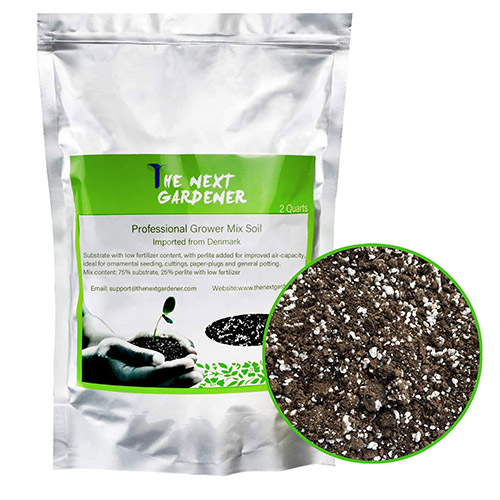
When it comes to succulents, The Next Gardener really knows their stuff. They value their knowledge and expertise so highly that they have created a company around it. For this reason, at Yard and Garden, we have faith in their expertly formulated soil blend, which is suitable for both succulents and bonsai house plants.
This soil mixture is all-natural and organic. It doesn’t have any large lumps and is airy, light, and fluffy. It has all the necessary qualities for succulents to be well-fed and taken care of, including being pH neutral and having excellent water drainage. 75% blended substrate of soil, sand, and other fine minerals and 25% perlite yay!
Pros
- 100% organic and natural
- Great soil mix that promotes the growth of healthy succulent plants
Cons
- Another pricey soil mix compared to the amount you receive
4. Wonder Soil’s Cactus & Succulent Soil Mix, 3 Lbs
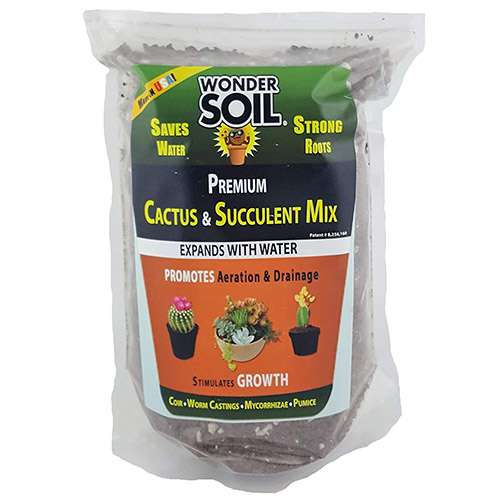
This is a fantastic succulent soil mix, regardless of your level of succulent growing proficiency, whether you’re growing from seed, offset, or repotting young or established succulents. It’s actually Wonder Soil! This organic soil mixture has been scientifically created and is bursting at the seams with nutrients that have been proven to promote succulent growth, strengthen roots, and increase soil aeration.
Putting the mix in the pot first, adding water, watching it expand, and then planting your rootings or succulent plants has proven to be beneficial to us here at Yard and Garden. Watch it grow; you heard us correctly. The coconut coir addition, which is best known for its capacity to retain water, provide excellent aeration, and improve drainage, is the sole cause of the “expanding soil.”
Coir, magnesium, gypsum, pumice, rock minerals (grit), humus, worm castings, and a few other excellent ingredients are included in this super mix. Because I would choose the product with perlite if I had a choice—just my personal preference—this is the only reason it didn’t land on the podium. As usual, if there is access to more coarse grit or gravel, I would add that as well.
Pros
- All-natural with a great cocktail of ingredients, including coir kelp and pumice
- Specifically designed for the growing needs and conditions of succulents
Cons
- Lacks perlite, but does contains pumice, a great alternative
5. Miracle-gro Succulent Potting Mix For Cactus, Aloe Vera & More 4 Qt.
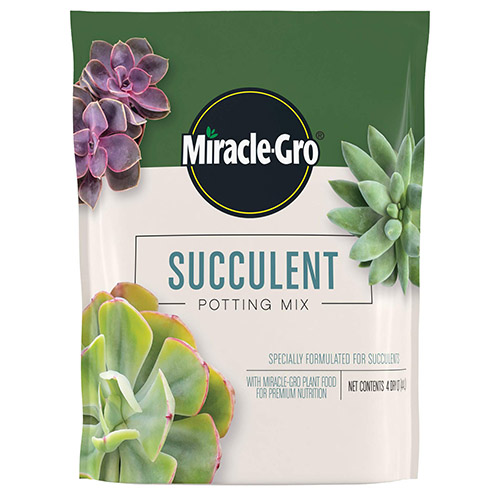
Miracle-Gro Succulent Potting Mix has been specially formulated for growing succulents and producing the ideal soil conditions for them to thrive, just like the Wonder Soil mix we previously featured. Using a different combination of ingredients this time, including sphagnum peat moss, forest products, and fertilizer. There are fewer mineral components in the bag here, so add some perlite once more.
A useful tip. For example, if you live in an apartment or simply lack the physical ability to lift large bags of gravel for your garden. Use these small, handy bags of ready-made compost and a bag of perlite together for the drainage and aeration that succulents and cacti love. I prefer Perlite to gravel or grit because it is so light and manageable. Just be careful to wet it before pouring to prevent any dust from escaping, especially if you’re inside.
Pros
- Specifically purposed for succulent growing
- Miracle-Gro makes everything convenient and this is no different with added fertilizers
Cons
- Premium price
6. Cactus Focus Potting Soil For Succulents 8 Litre
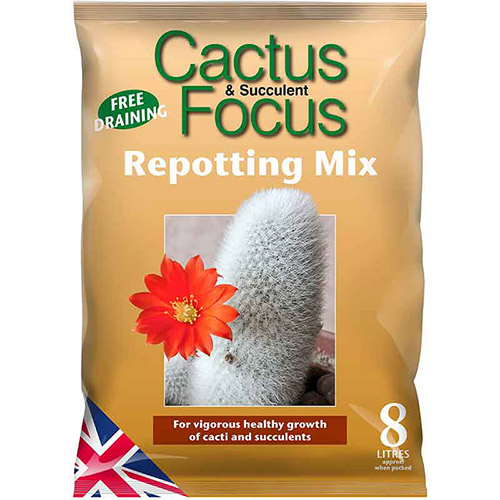
Use this re-potting mix from Cactus & Succulent Focus with the majority of cacti and succulent species. We’ve tested the products from Growth-Technology, a different British company, many times on The Yard and Garden, and we’ve always been impressed.
This soil is notable for having coconut coir, sand, and grit to aid in the crucial water retention while maintaining good aeration. The nutrients are obtained from a peat-free, well-drained soil that is nice and light and fluffy. On Amazon.co.uk, you can purchase 8 liters in a bag for a very affordable price. Therefore, I recommend adding a few handfuls of perlite with some of the money you have left over. Once done, the mixture will be ideal.
Pros
- A really nice light soil with coir, sand, gravel
- Good value for money for an 8L bag
Cons
- Like most of the blends on our list a few scoops of perlite needed to level up to a perfect succulent soil
7. Hoffman Organic Cactus And Succulent Soil Mix, 4 Qrts
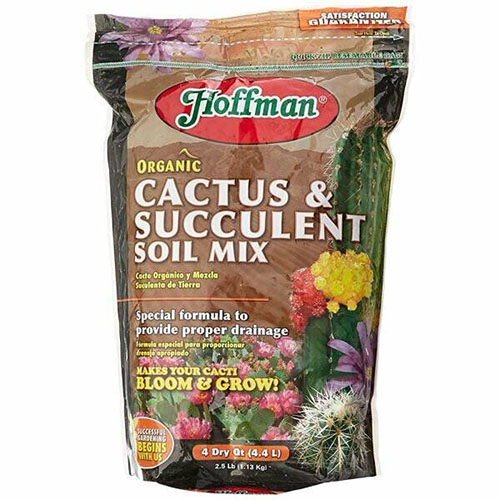
By planting your new and established succulents in Hoffman’s Organic cactus and succulent soil mix, you can watch them thrive. At Yard and Garden, we value the pH balance and succulent-friendly formulation of this specific soil blend.
In addition to indoor succulents, this multipurpose soil mix is suitable for cacti of both desert and jungle varieties, and can be used right out of the bag. A convenient set of instructions with helpful growing hints and tips is also included with the soil. Excellent for both novice and expert succulent growers.
Contains limestone, perlite, sand, reed sedge peat, and Canadian sphagnum moss.
Pros
- Ready to use formula, no need for additional minerals
- Drier than many soil mixes, offering a good base soil for succulents
Cons
- Can be little more expensive in some stores
8. Perfect Plants All Natural Succulent And Cactus Soil
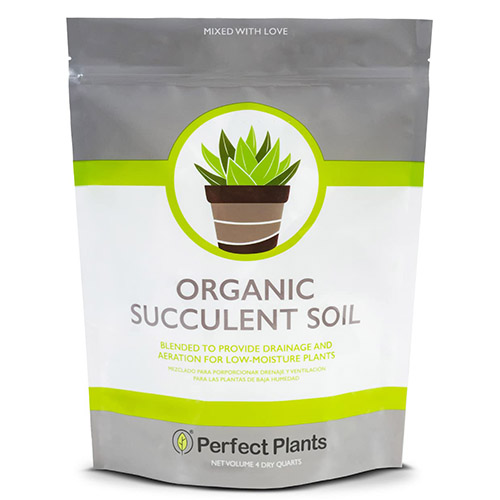
For potting up small succulents, use this inexpensive soil mixture. The ziplock-style bag is simple to reseal for storage inside. An adequate drainage system is facilitated by the sandy soil texture. It is best for succulents with moderate water needs because it may not drain as well as some other options.
Pros
- Affordable soil for small succulents
- In resealable zip-top bag
- Good drainage for most succulents
- Contains organic ingredients
Cons
- Can hold too much water for some succulents
- Bag holds only 4 quarts of soil
9. Superfly Bonsai Succulent & Cactus Soil Mix
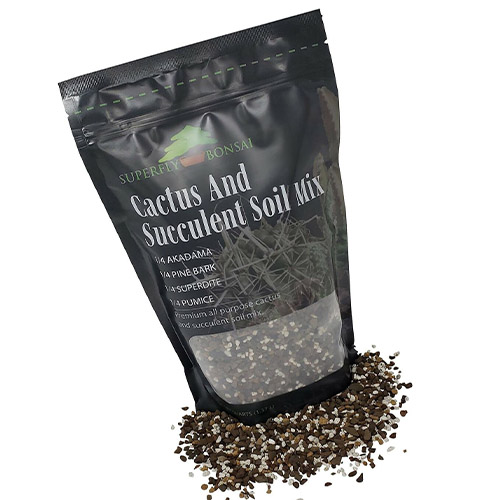
This pre-mixed product, which doesn’t contain any actual soil but is sifted before packaging to make sure there are no clumps, aerates well, and is packaged. The all-substrate formula, which you can use either by itself or in combination with your existing soil, ensures proper drainage for outdoor succulents. You can use a little at a time and keep animals out thanks to the zip-top bag design. Larger quantities of this product are also offered.
Pros
- Good choice for outdoor succulents
- All-substrate formula provides good drainage
- Seals in zip-top bag
- Comes in bigger quantities
Cons
- Only 6 quarts of soil in bag
- Costs more than some
Importance Of Fertilizing Succulents
Numerous varieties of succulents don’t ever need to be fertilized and still grow well and steadily. However, adding fertilizer will help your succulent soil reach its full potential, encouraging more vibrant foliage and prolific blooms. Your succulent plants’ general health and longevity will increase with a high-quality organic fertilizer.
Look for a fertilizer that has been designed especially for cactus and succulent plants. The fertilizer ought to have beneficial soil microbes and a low nitrogen content. A slow-release formula that will feed the succulent plant whenever it needs nutrition is necessary because succulent plants do not constantly absorb water from the soil.
Related Reading: Fertilizer For Succulents
Succulent Soil Recipe
Mixing organic and inorganic materials creates the substrate for succulents. In layman’s terms, the inorganic elements are richer in drainage and porosity, while some organic elements also contribute to porosity. The organic elements will provide nutrients. The most popular ingredients in soil mixtures for succulents and cacti are listed below.
Inorganic Components
- Coarse sand
- Vermiculite
- Perlite
- Gravel
- Expanded clay
- Pumice
- Volcanic rock
Organic Components
- Peat moss
- Pine bark
- Coconut coir
- Rice husk
- Wood chips
- Compost
- Earthworm humus
It is recommended to use more inorganic components than organic ones. This ensures drainage, porosity, and a low nutrient composition—the three qualities that the substrate must possess for your succulents.
To create your own recipe for succulent soil, research each ingredient, determine whether it is available locally and how much it costs, and learn about the benefits each one offers. Remember, again, that there are also ready-made options.
Factors To Consider When Choosing The Best Soil For Succulents
Your gardening endeavors will come to an abrupt end if you pot your succulents in the incorrect soil. Succulents will suffer stress and waterlogging in unsuitable soil, and they will eventually perish. While some succulents are more resilient than others, all succulent plants will benefit from the right soil. Since the majority of succulents (and cacti) are native to dry regions with little to no rainfall, they do not do well in soil that is overly wet or heavily watered.
Indoor Vs. Outdoor
There are many soils for indoor houseplants available that are designed specifically for succulents. If you want to grow succulents outdoors, you might wonder what to do. Your need for soil volume is a crucial factor in outdoor gardening. You might have to focus more on pricing because you’ll presumably need more. Conditions outside and inside are very dissimilar. Plants typically receive more sunlight and airflow, which helps prevent water-logged soil. As a result, you can choose planting soil for succulents outdoors with a little less caution. Nevertheless, it’s crucial to select a mixture that encourages good drainage.
Organic Vs. Nonorganic
Choose an organic soil mixture if you’re worried about exposure to chemicals. You should be aware that organic soils are typically more expensive than nonorganic ones. Succulents are not edible, so there is less of a concern about chemical exposure than when you are growing food. Nonorganic soil is a good option for this plant if cost is a concern for you.
Soil Vs. Mineral Ratio
Minerals and organic matter are present in all soils. In comparison to soil used for other purposes, succulent soil contains more minerals. While minerals aid in drainage, organic materials retain water and provide nutrients to plant roots. Depending on the kind of succulent you’re growing, the mineral to organic content ratio will vary. For the majority of succulents, sandier soil is preferred because it facilitates better drainage.
Read More: What Type of Potting Soil Do Succulents Need?
Container And Drainage
No matter what kind of plant you are growing, avoid potting your plants in containers without drainage holes. Although drainage holes are very helpful in preventing root rot, you can also add rocks or gravel to the bottoms of pots to promote drainage. It’s simple to tell when you’re watering a plant too much by using a planter with drainage holes and a saucer. Succulents can also be kept in nursery pots and placed in cachepots, but remember to frequently check the bottom of the pot for water buildup after watering.
How To Take Care Of Succulents?
Avoid non-draining containers: Succulents are not well-suited to long-term care in any non-draining pot, particularly a glass container. They don’t like to grow in soggy or wet soil. Succulents require sufficient airflow to maintain healthy stem, leaves, and, most importantly, roots, so choose pots that are well-draining and permeable to ensure their happiness.
Place succulents near a window: It can be challenging to give succulent plants enough sunlight indoors. Up to six hours of indirect sunlight are required each day for these plants. Placing indoor plants close to a window or in the brightest area of your house is the simplest way to give them indirect sunlight.
Rotate the plant often: So your succulent will spend the day getting some sun by sitting on the window sill, okay? However, because it will always be in the same place, it is highly likely that only one side of the plant will receive enough light. Make it a routine to rotate your succulent every couple of days or so.
Water the soil directly not the plant: Ensure that you directly soak the soil when you water your succulents. Use a spray bottle sparingly; misting will result in moldy leaves and harm the roots. Placing the pot in a pan of water is another way to hydrate your succulents. Take the pot out of the pan once the topsoil is moist.
Read More: How to Care for Outdoor Succulents?
How Much Water Do My Succulents Need?
Always keep your succulents out of standing water, as a general rule.
Another quick way to kill your indoor succulent plants is to water them every day. Yes, succulents enjoy having their roots wet, but they frequently dry out. In comparison to fall and winter, spring and summer require more water.
A succulent kept indoors will thrive with roughly 2 cups of water every other week during the warmer months. In the winter, cut back on the watering to just one cup once a month.
Related Reading:
Our Verdict
Our top pick, Perfect Plants All Natural Succulent and Cactus Soil, has natural ingredients and is reasonably priced, which will appeal to new plant parents and lovers of small indoor succulents. Use the Superfly Bonsai Succulent & Cactus Soil Mix to provide outdoor succulents with a strong soil foundation.
FAQs
What Type Of Soil Is The Best For Succulents?
It’s best to have a sandy, permeable soil. Drainage will be aided by soil that contains at least 50% of perlite, sand, and other minerals. The drainage will be better the higher the mineral content.
Can You Use Regular Potting Soil To Grow Succulents?
First and foremost, the ideal succulent soil should be poor, permeable, and slightly acidic. Specialized retailers offer special succulent or cactus soil since regular potting soil does not meet these requirements. You must combine regular potting soil with soil amendments in order to use it for succulents.
Do Succulents Need Special Soil?
Experiencing difficulties while trying to grow succulents and unsure of the issue? The soil may hold the solution.
Any plant can be grown more successfully if its natural environment is replicated. Sand and gravelly soil is where most wild succulents grow. Numerous even flourish in narrow rocky crevices or along cliff edges. Although heavy rains quickly dry out their native, rocky soils, they become saturated.
Overwatering is by far the biggest killer of succulents, and root rot is the biggest danger to their survival.
The entire plant will deteriorate and eventually perish if the roots, which serve as the primary pathway for water and nutrient uptake, are damaged. It goes without saying that a succulent’s ability to survive and grow well depends greatly on the drainage of the soil.
It is imperative to plant succulents in the proper soil as a result. The following characteristics describe good succulent soil.

